Every home has a number of filters and screens that perform a variety of cleaning tasks. Filters and screens are installed as part of appliances and other devices to keep contamination out of our homes and/or prevent dirt, dust and grime from damaging our homes. All of this keeps are homes safer and more comfortable places to live.
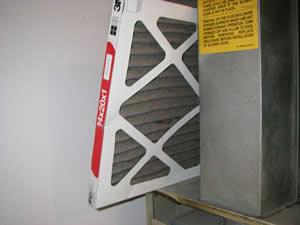
Dirty furnace filter
However, if you do not replace and clean the screens and filters that exist in your home you are creating the perfect medium for bacteria and mold to live and grow, creating an unhealthy home environment.
Following is a list of the most common filters and screens that must be cleaned or replaced on a regular basis.

Figure 1 - HEPA air purifier filter
- Dryer Lint Filters:
Many homeowners are utilizing air purification systems that use a variety of different types of filters. Many of these air purifiers use HEPA filters, as shown in Figure 1, which get clogged with dirt and dust and cannot be cleaned, hence they must be replaced.
If you do not replace the air filters on these air purifiers your investment in the product has been a waste.
Most continually operating air purifiers require a filter change at least every 6 months. Follow the air purification system manufacturer’s instructions as to how often the filters and other parts should be cleaned and replaced.
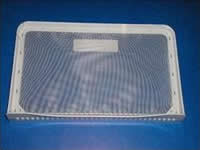
Figure 2 - Clothes dryer lint filter
- Exhaust Fan Grills:
Your dryer requires the free flow of air to work properly and efficiently. Dryer lint filters, as shown in Figure 2, should be cleaned after each full operational cycle of the dryer. In other words, dry a load of clothes and clean the lint filter.
The chamber that the dryer lint filter sits in should also be cleaned on a regular basis using a vacuum cleaner. The dryer vent pipe and the outdoor cover should be inspected and cleaned regularly to avoid the build-up of lint which is a major cause of house fires.
Additional information on cleaning dryer vents.
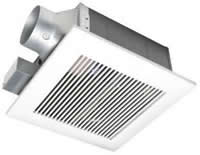
Figure 3 - Exhaust fan grill
- Furnace Filters:
Exhaust fans are usually found in bathrooms, laundry rooms and in some cases kitchens. The primary use of exhaust fans is to vent high levels of moisture out of the room. As well they vent unwanted odors.
Exhaust fans do not have filters. They use a decorative grill, as shown in Figure 3, that all of the air that is exhausted from the room must pass through. Depending on the room and geography there can be high levels of dust and lint being drawn into the exhaust fan. As the grill becomes covered with dirt and/or lint the exhaust fan motor must work harder to exhaust the air from the room.
Exhaust fan grills should be vacuumed monthly and removed every 6 months so that you can vacuum inside the exhaust fan. Many exhaust fan grills use a spring mount mechanism making it relatively easy to lower the grill and vacuum inside.
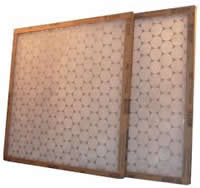
Figure 4 - Furnace filters
- Range Hoods:
The furnace filter, as shown in Figure 4, is placed on the cold air return side of the furnace duct work system. It is installed to prevent dust and dirt from circulating throughout your home. The more dust and dirt that accumulate on the furnace filter the harder the blower motor in the furnace must work to circulate the air. When motors work harder they consume more energy, hence the cost of operating the furnace increases. As well, the harder the motor on the blower must work, the more it is wearing and will need replacement sooner than necessary.
Furnace filters are relatively inexpensive products. Depending on the size of your furnace filter a cost of $3 is average. Higher quality filters last longer but cost more.
You should change your furnace filter once a month during its operational season, which of course includes cooling if you have a central air conditioning system.
There are two types of filter configurations for range hoods.
Range hoods that are vented to the outside, this is the best operational installation, should have a wire mesh grill which acts as a grease filter, as shown in Figure 5. Grease filters need to be washed on a periodic basis, depending on the type and amount of range top cooking occurring in your home, this could be as often as weekly to once a month.
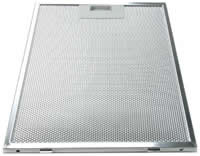
Figure 5 - Range hood grease filter
Because it is a grease filter, it prevents grease from entering the range hood exhaust fan and duct work. Allowing an accumulation of grease to build up on the wire mesh grill is a potential fire hazard. As well old grease is a perfect medium for the growth of bacteria.
Range hoods which are not vented to the outside not only require a grease filter but they require a filter that will remove odors that accompany cooking foods. These types of filters generally use a charcoal product to eliminate odors. Some range hoods use independent charcoal filter, grease filters and grills others use a filter that is a combination grease grill and odor filter, as shown in Figure 6.
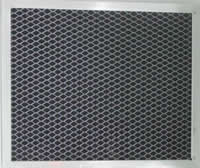
Figure 6 - Range hood charcoal/grease filter
- Refrigerator Filters:
Charcoal filters cannot be cleaned and must be replaced. The frequency of replacement is relative to how much cooking; especially frying is done in the kitchen. However, in most homes charcoal range hood filters should be replaced at least every three months.

Figure 7 - Refrigerator water filter
- Water Purification Filters:
Many of today’s refrigerators have water and ice dispensers on the front of the refrigerator door. Most of these systems use a filter, as shown in Figure 7, to eliminate contaminates in the water. These filters must be changed on a regular basis; most are based on a period of time and has little if anything to do with the amount of water or ice used.
Follow the refrigerator manufacturer’s instructions as to how often the water filters should be replaced.
There are many types of water purification systems. Some are designed to provide water purification to the entire home, while others are designed to work on specific faucets. All water purification systems have consumable filters, as shown in Figure 8 and/or UV lamps that are the key to the water purification process.

Figure 8 - Water filter cartridge
Many of these filters have specific replacement periods that are not relative to the amount of water that passes through them. Some filters will actually allow bacteria to grow on them and hence must be replaced to maintain a safe water supply for your family.
Follow the water purification system manufacturer’s instructions as to how often the water filters, UV lamps and other parts should be cleaned and replaced.
